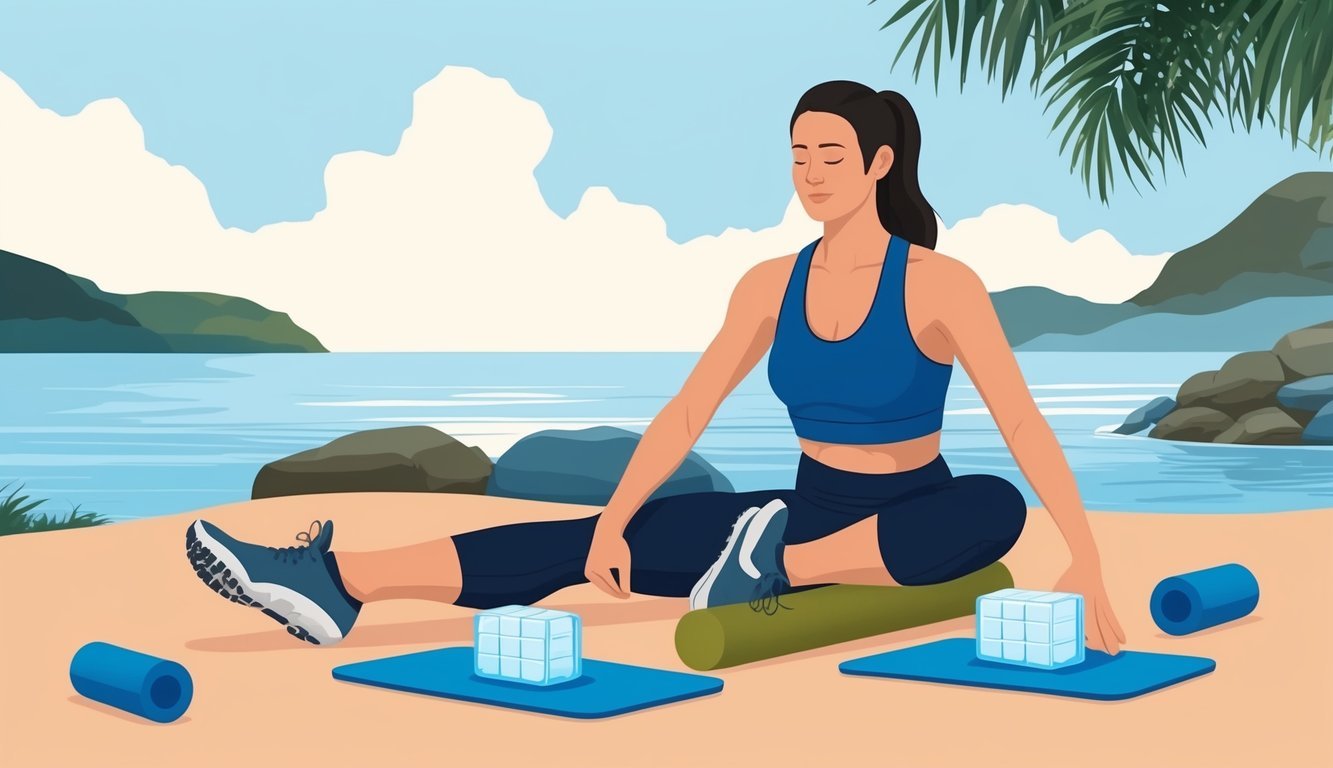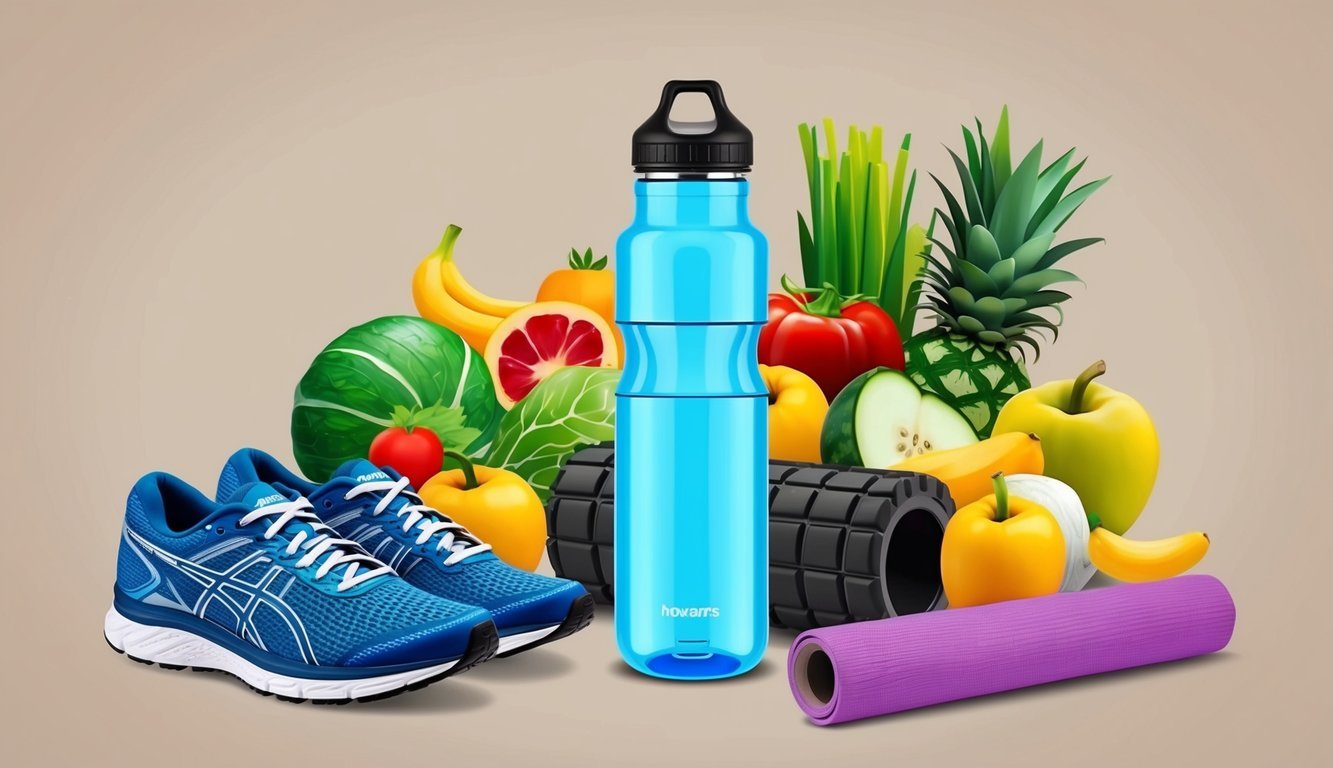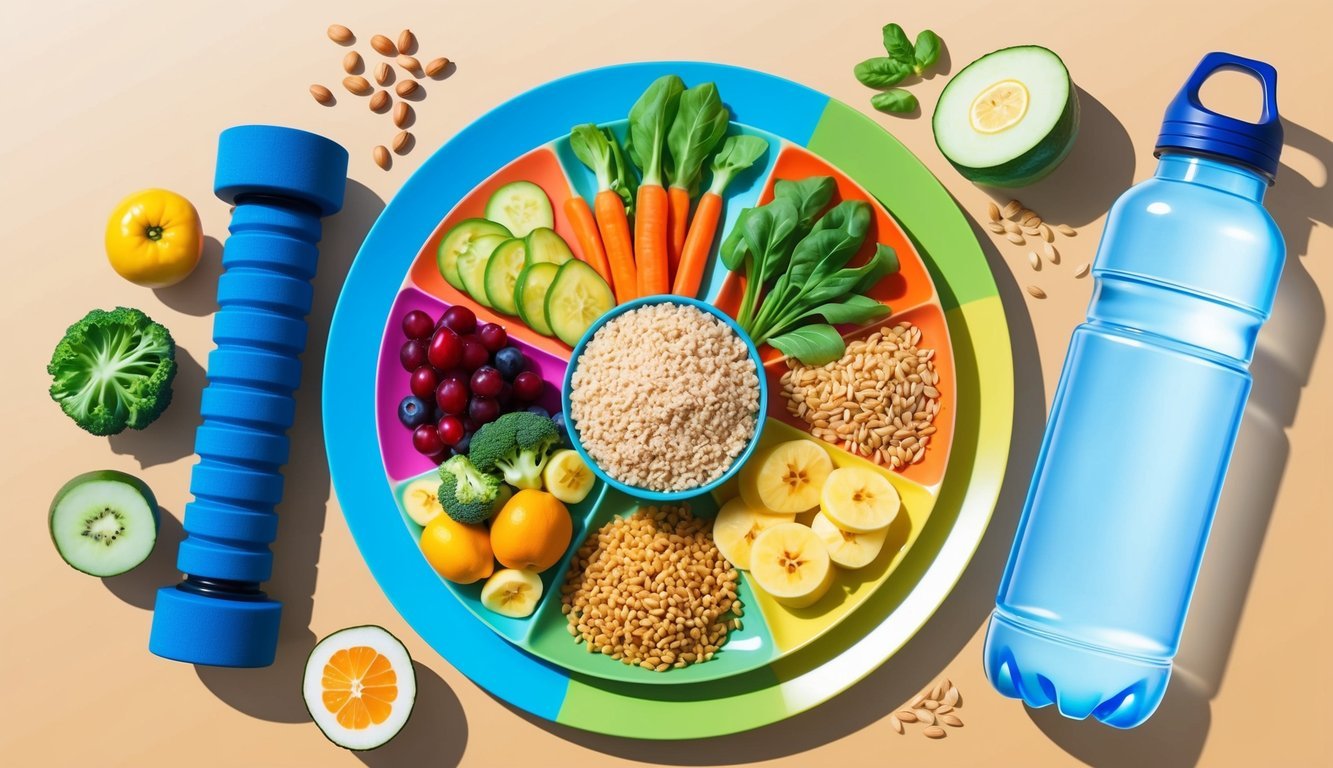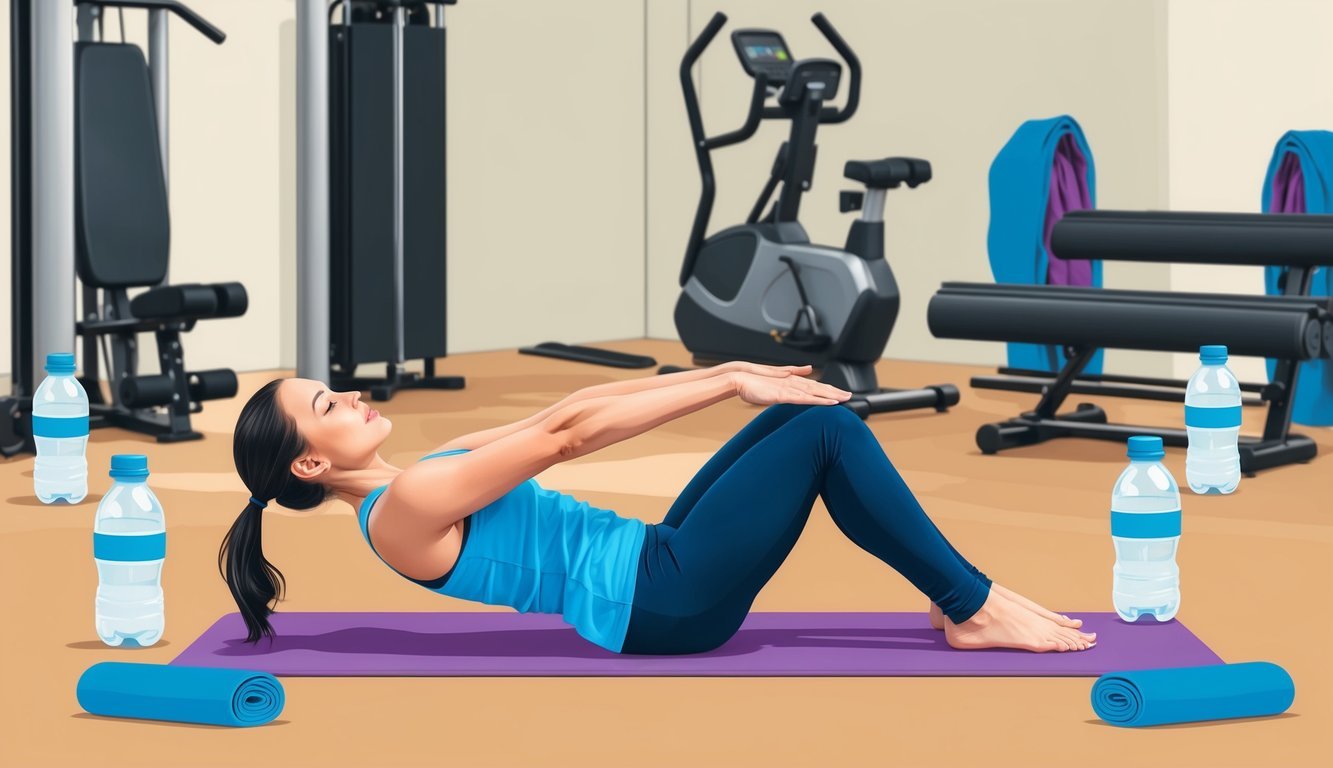After an intense workout, muscle soreness can sometimes be quite overwhelming.
Anyone who pushes their limits will experience this, and knowing how to manage that discomfort can make a significant difference in your recovery routine. Understanding effective strategies for reducing soreness is essential to staying active and maintaining motivation.

There’s nothing worse than feeling stiff and sore after a great session at the gym.
It can really put a damper on your plans to stay fit and keep pushing forward.
Thankfully, there are several simple tips that can help ease soreness and speed up the recovery process.
1) Stay Hydrated

I’ve learned that staying hydrated is crucial for reducing soreness after an intense workout.
Dehydration can slow down recovery and make your muscles feel worse.
I aim to drink plenty of fluids before, during, and after exercise.
Keeping a water bottle handy helps me stay on track.
When I sweat, I lose electrolytes, so I consider drinks that replenish them.
I also focus on my body’s signals.
If I feel thirsty or fatigued, I make it a point to hydrate more.
A good rule I follow is to drink about 1.5 liters for every kilogram I lose during my workouts.
That’s roughly three cups of fluid for every pound lost.
Sometimes, I add a splash of electrolyte drinks or coconut water to my routine.
It not only tastes good but also helps my muscles recover faster.
Staying hydrated has made my post-workout recovery smoother and less painful.
2) Stretch Regularly
Stretching is a crucial part of my routine to keep soreness at bay after intense workouts.
I often find that taking the time to stretch before and after exercising really helps me manage muscle tightness.
I like to incorporate both dynamic stretches, which involve movement, and static stretches, where I hold each stretch for about 30 seconds.
This combination seems to work wonders.
Cat-cow stretches are a favorite of mine for releasing tension in my back.
It’s important not to bounce while stretching.
I focus on smooth movements to avoid any risk of injury.
Stretching can enhance my flexibility and overall range of motion, making my workouts feel better in the long run.
I try to target specific areas that feel sore, spending a bit more time on those.
Regular stretching not only helps reduce post-workout soreness but also keeps me feeling limber and ready for my next session.
Foam Roll Daily
I’ve found that incorporating foam rolling into my daily routine makes a noticeable difference in reducing muscle soreness.
It’s a simple yet effective way to aid recovery.
After a tough workout, I grab my foam roller and spend a few minutes targeting the muscle groups I just used.
The gentle pressure helps to release tension in my muscles, making them feel more pliable.
I roll slowly, about an inch per second, especially when I hit a tender spot.
Holding it for about 20 seconds helps, and then I continue rolling.
Focusing on areas like my glutes and lower back feels great.
It’s also beneficial to foam roll before stretching.
By loosening up my muscles first, I can stretch more effectively.
I usually dedicate around one minute to each muscle group, keeping it manageable and not going over two minutes on any one spot.
Consistent foam rolling helps keep my muscles flexible.
When I make it a daily habit, I notice I recover faster and feel less soreness after intense workouts.
Ice Baths
I’ve recently started incorporating ice baths into my recovery routine.
They can really help reduce muscle soreness after intense workouts.
When I spend time in an ice bath, my body cools down, which constricts blood vessels.
This process lowers metabolic activity in the muscles, helping to ease soreness.
It feels refreshing, especially after a tough session.
Sometimes, I’ll take a dip right after exercising.
This seems to speed up my recovery and decrease inflammation.
I’ve noticed I can bounce back quicker for my next workout.
While some folks might prefer ice baths a few times a week, I find that taking them consistently works best for me.
Overall, it’s become a ritual that I look forward to.
By helping reduce delayed onset muscle soreness, the ice bath has become a key part of my post-exercise routine.
I simply feel better prepared for my next challenge.
5) Compression Gear

I’ve found compression gear to be super helpful after intense workouts.
These garments snugly fit around muscles and joints, which can really support recovery.
Wearing compression clothing, like sleeves or tights, helps with blood flow.
This increase in circulation can reduce soreness, allowing you to bounce back faster after hard exercise.
Additionally, compression gear can provide muscle support and reduce fatigue during workouts, enhancing overall performance.
When combined with barefoot training benefits, such as improved balance and foot strength, athletes may experience greater stability and efficiency in their movements.
This holistic approach to training can contribute to better recovery and long-term injury prevention.
I appreciate how it minimizes the effects of delayed-onset muscle soreness (DOMS).
After a tough session, I’ll slip on my compression gear and feel a bit more comfortable.
It’s important to choose the right fit.
Too tight can be uncomfortable, and too loose won’t provide the benefits I’m looking for.
Many options are available, so you can pick based on what feels best.
Whether I’m running, weightlifting, or doing yoga, compression gear can help alleviate some of that post-workout discomfort.
6) Sleep Well

Getting enough sleep is crucial for muscle recovery.
When you sleep, your body goes into repair mode, helping to heal those tiny tears in your muscles from workouts.
I aim for 7-9 hours of quality sleep each night.
This helps with muscle recovery and reduces feelings of soreness.
If I skimp on sleep, I definitely feel it the next day.
Creating a bedtime routine really helps.
I try to wind down by avoiding screens and relaxing with a book.
This signals my body that it’s time to rest.
I also make my sleep environment comfortable.
I keep my room dark and cool.
Using a white noise machine can also help drown out distractions.
I pay attention to my sleep patterns.
Tracking how I feel after different amounts of sleep has helped me understand what works best for me.
Good sleep hygiene can go a long way in reducing that post-workout soreness.
7) Balanced Diet

When it comes to reducing soreness after an intense workout, a balanced diet plays a crucial role.
I focus on consuming a mix of proteins, carbohydrates, and healthy fats.
This helps my body recover more effectively.
Protein is essential for muscle repair.
I make sure to include sources like chicken, fish, and plant-based options in my meals.
After a workout, I often reach for a protein smoothie to kickstart recovery.
Carbohydrates help replenish glycogen stores.
I enjoy whole grains, fruits, and vegetables to fuel my body.
These foods not only provide energy but also vitamins and minerals that support recovery.
Hydration is vital too.
I aim to drink plenty of water throughout the day, especially after exercising.
Sometimes, I opt for electrolyte-rich drinks to replace what I’ve lost during my workouts.
Lastly, I’ve found that certain foods like tart cherry juice can also help reduce muscle soreness.
It’s all about finding what works best for me and maintaining that balanced approach.
8) Active Recovery

I’ve found active recovery to be a game changer for soreness after a tough workout.
Instead of lounging around, I focus on low-intensity activities.
It really helps my body recover.
Light exercises like walking, swimming, or cycling keep the blood flowing.
This boosts circulation, which can reduce inflammation and aid in muscle repair.
I often take a casual stroll or hop on a stationary bike for about 20-30 minutes.
Another favorite of mine is yoga.
It’s not just about stretching; it helps me clear my mind and rejuvenate.
I enjoy slower-paced classes that promote relaxation while still engaging my muscles.
Foam rolling is also a solid addition to my routine.
It targets tight areas and helps alleviate tension.
The combination of these practices makes managing soreness much easier for me.
9) Epsom Salt Baths

I love treating myself to an Epsom salt bath after an intense workout.
Epsom salt, or magnesium sulfate, can help relax my muscles and ease soreness.
I typically aim for water that’s comfortably warm, around 92-100°F (33-38°C).
I add about 2 cups of Epsom salt to my bath.
If my tub is larger, I might need a bit more.
Soaking in the bath helps loosen stiff joints, making it a great option for post-workout recovery.
The magnesium in the salt can reduce inflammation and swelling, which I really appreciate after a tough session.
Not only does it feel soothing, but it also gives me a mental break.
I find that taking the time to relax in the bath helps me unwind and feel refreshed.
It’s a simple way to care for my body while enjoying a bit of self-care.
Understanding Muscle Soreness

Muscle soreness is a common experience after intense exercise, and knowing its causes and types can help you manage it better.
Recognizing these aspects can also guide your recovery strategies.
What Causes Soreness?
Muscle soreness typically occurs when exercising causes microscopic damage to muscle fibers.
This damage happens when we push our limits, especially with strength training or high-intensity workouts.
Our bodies respond by initiating the repair process, leading to inflammation—this is what makes us feel sore.
Lactic acid production during workouts can also contribute to the burning sensation we might feel.
While lactic acid doesn’t cause delayed soreness, it adds to the discomfort during and immediately after intense physical activity.
To prevent excessive soreness, focus on proper form, gradual intensity increases, and staying hydrated to support muscle recovery.
Difference Between Acute And Delayed Soreness
There are two main types of muscle soreness: acute and delayed.
Acute soreness occurs during or immediately after exercise.
It’s often a result of lactic acid buildup and is usually short-lived.
We feel this type of soreness as a burn during intense activity, indicating that our muscles are working hard.
Delayed soreness, also known as Delayed Onset Muscle Soreness (DOMS), sets in 24 to 48 hours post-exercise.
This is primarily due to the microtears in the muscles I mentioned earlier.
With DOMS, we experience stiffness and pain, particularly with movement.
It’s a normal part of the muscle adaptation process and usually resolves within a few days.
Understanding the timing of these types helps us better track our recovery and adjust our routine accordingly.
Lifestyle Changes To Prevent Soreness
To tackle muscle soreness, tweaking your lifestyle can make a big difference.
Focusing on what you eat and how much you hydrate are two key areas that help you stay on top of your game.
Dietary Adjustments
Eating the right foods is crucial for muscle recovery.
Always aim to include a good balance of protein, carbohydrates, and healthy fats in your meals.
Protein helps rebuild muscles, while carbs replenish energy stores.
Some of my favorite recovery foods include:
- Lean meats like chicken and turkey
- Fish rich in omega-3 fatty acids, such as salmon
- Whole grains like brown rice and quinoa
- Fruits and veggies packed with antioxidants, like berries and spinach
Make sure to get enough vitamins and minerals, especially magnesium and potassium, which support muscle function.
A well-rounded diet not only helps with soreness but also boosts overall performance.
Importance Of Hydration
Hydration is another piece of the puzzle.
Water is essential for muscle function and aids in nutrient transport.
I try to drink about 1 cup of water during my warm-up and continue to hydrate throughout my workout.
Here’s my hydration schedule:
- 1 to 1.25 cups every 10 to 20 minutes during exercise
- 1 cup within 30 minutes after finishing my workout
If I feel sore, I sometimes switch it up with ice or heat therapy as well.
Proper hydration keeps my muscles feeling good and can help prevent soreness before it starts.

